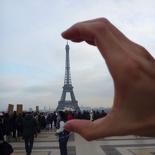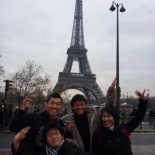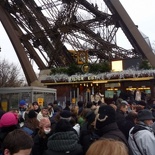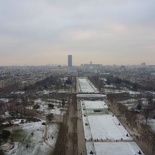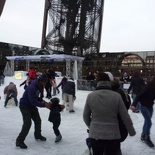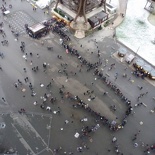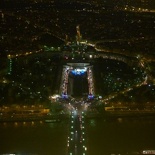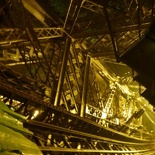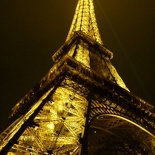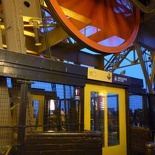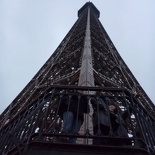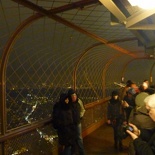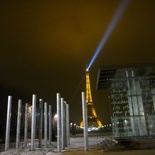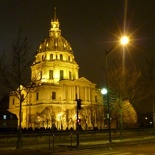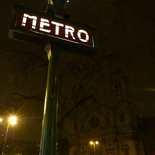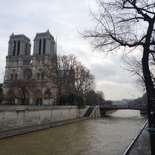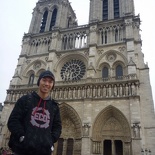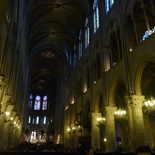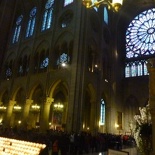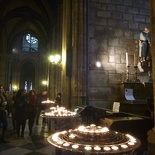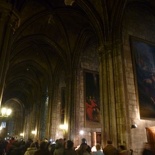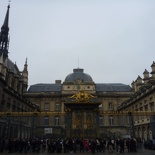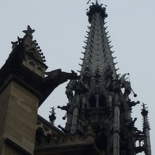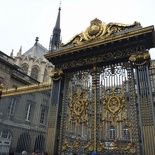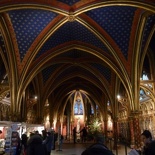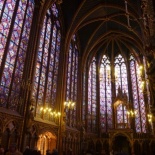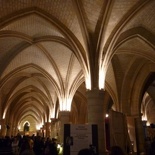This part of my blog focuses on the various key attractions in the city of Paris itself, namely the Paris Eiffel Tower, Notre Dame cathedral and the Sainte Chapelle.
Paris Eiffel Tower
The iconic Eiffel Tower in Paris is both a global icon of France and one of the most recognizable structures in the world. Also known as The Iron Lady (La dame de fer) she was built in 1889 and is structurally a huge iron lattice structural tower made out of scrap metal recycled from the world war, due to a shortage of raw materials. The tower was built over a period of 2 years as the entrance arch to the 1889 World’s Fair, it sits on the Champ de Mars boulevard and is the tallest man-made structure in the world for 41 years, until the Chrysler Building in New York City overtook it in 1930. It is still the tallest building in Paris and the most visited entrance fee-paid monument in the world.
We started off our trek to the Eiffel tower from the metro’s Trocadero station. The station will land you right on the Trocadero circle right in front of the architecture museum, The Cité de l’Architecture et du Patrimoine located in the Palais de Chaillo. The Palais (or palace) de Chaillot is now a building housing several museums overlooking the Eiffel tower. This high spot here offers the best views and photo shots of the tower from afar. Thereafter, it will be a short walk east bound along the fountain terrace and park which makes up part of the Jardins du Trocadero in front of the museum. The spot here is a tourist trap, so be expecting lots of people hawking wares and souvenirs around here. Several food and gift stalls line the pavements leading to the Pont d’Iena which spans over the Seine.
It’s only much closer to the tower where you can actually grasp the size of the structure. Sitting at the bottom of the tower is a large concrete paved plaza which is home to mostly crowds queuing to go up the tower. You can enter the tower via any of the 4 legs, as long the stairwells and lifts on that section are open. I do not get the long queues and crowds here, with all full able-bodied people queuing for hours just to get a lift up (with disabled access) to the tower. We managed to get tickets in less than 10 minutes in the queue and got up the tower via the steps, after a slow 10 minute climb we were all up the the first level observation deck.
Here, grated fences line the overhanging railings of the tower. The walkways here are laid out with a historical showcase of the tower itself showcasing how the idea to built the tower was conceived and the materials (tank steel) produced to overcome the demand for steel and iron to build this tower. A restaurant, ice skating rink as well as few shops reside up here too.
As with all observation buildings I visit around the world, its always the best to head up the attraction just before sunset so you can catch both the day and night views of the city on a single trip, besides catching views of the city slowly transforming into a sea of lights. The stairs also serve the tower’s 2nd Level, which is another 10-15 minute climb up. Personally if you are fit to be able to do it, the stair climb up the Eiffel tower is the best way to see the tower and all it’s inner workings and details, it’s just like a city steam punk world of industrial beams and girders, contrary to the minute long lift ride up and down with the other guests packed like sardines with nothing much too see out of the lift windows.
Entry to the Tower’s Summit (The 3rd Level) will set you back another 15 Euros. It’s good that they split up the fees for the lower and upper decks as not everyone here would like to go up to the top, or find the fees as a deterrent to visit the retail establishments on the first level deck. The journey up here to the upper-most 3rd level deck is through a long slender stem which rises from the balcony of the 2nd floor of the tower. Here, you do not have the option to take the stairs up despite the top being served by steps, only that they are out of bounds and used for maintenance and emergency purposes only. The top of the tower is a two tiered observation deck, complete with an indoor enclosed area as well as an outdoor caged summit view deck. It can get rather windy up on the tower, not to mention chilly in winter too, so do pack some thicker jackets if you are up here. Amazingly,there is even a small bar located right at the top of the tower, and do the views just gets better with each climb!
So that’s a tower conquered, up and down via the stairs with the exception of the lift to the deck at the top. Moving further south east on the garden back on ground level will bring you along the Champs de Mars leading up to the Paris military school, also known in French as the The Ecole Militaire, here resides the Peace Monument too, with nice views of the Eiffel tower in the background. You will come upon the Hotel des Invalides where’s Napoleon’s Tomb is located, as well as one of the longest avenues I’ve ever seen in Paris, the Pelouse de l’avenue de Breteuil.
:: Photos taken on the Eiffel Tower
Next up, the Notre Dame!
Notre Dame de Paris
The Notre Dame Cathedral is a Gothic Catholic cathedral just not off Cluny in downtown Paris (nearest metro: Saint-Michel-Notre-Dame). It’s located on the eastern side of the city on an “island avenue” which is served by bridges crossing over the Seine. Also known as “French for Our Lady of Paris”, the Notre Dame de Paris is widely known as a one of the few buildings standing today offering the finest examples of French Gothic architecture in France and in Europe. While some will have an adherence of it being the feature point of a Disney movie with it’s infamous resident hunchback, the building is considered to be one of the best displays Gothic styled architecture complete with exterior gargoyles and chimeras perched on it’s balcony on the upper clock tower. The Cathedral is beautiful no matter where you look at it from- in front or just across the Seine, it’s just a magnificent sight to behold.
The idea for the Cathedral was conceived and constructed from 1163 into the 1240’s, with rather primitively methods and simple machines, it coincided with the musical experiments of the Notre Dame school. Another remarkable technological achievement at that time was the utilization of flying buttress in the construction of the Cathedral, despite it not being originally designed to include them. The Notre Dame de Paris was no exception either and was among the first buildings in the world to use this unique engineered build style to keep the roof up under it’s own compressive weight over the side walls without having the need for an extensive number of internal pillars holding the roof up. These flying buttresses are essentially arched exterior supports can be prominently seen on the insides and outside of the cathedral, where the roof meets.
Stone cladded walls line the internal of the cathedral, which is dark and gothic despite them not retaining much of the white sheen which they used to have. A combination of candle and electrical light give the cathedral a rather uniquely gloomy ambiance inside, which seem to go with it’s neoclassical architecture. A walkway lines the perimeter of the seating area, the center altar and serves the “museum displays” placed on the edges of the cathedral itself. Part of the cathedral display include various furniture, crosses, sculptures, stained glass and room settings of an era forgone.
Access to the iconic bell tower is made through the front entrance is chargeable via tickets purchased by the Cathedral’s fornt door. The central areas is home to 2 vast stained glass rose windows on the either side of the altar and are in contrast with earlier Romanesque architecture. The Cathedral organ resides here too, spotting 7,800 pipes, with 900 of them surviving through the test of time and classified as historical. The cathedral treasury here also houses a reliquary with the purported Crown of Thorns and with the cathedral being the Catholic Archdiocese of Paris, it is also home to the official chair of the Archbishop of Paris, who is currently André Vingt-Trois.
:: Notre Dame Cathedral Photo Gallery
Next up, the Sainte Chapelle.
Sainte Chapelle
The Sainte-Chapelle is a Holy Chapel located on the Île de la Cité, which is on the island surrounded by the Seine in the heart of Paris. The island in question here is similar to where the Notre Dame Cathedral is located too. Physically, the chapel is located in the courtyard of the royal palace on the Île de la Cité, built to house the Louis IX’s collection of precious relics of Christ, which included the Crown of Thorns. It is the the only surviving building of the Capetian royal palace, by the grounds of the Palais de Justice and is
considered to be among the highest achievements of Gothic architecture during the Rayonnant period.
The exterior of the chapel is decked typically in the Rayonnant architectural style, which is synonymous of the gothic architecture in it’s time. Several chimeras and gargoyles can be seen on the sharped spired roofs of the chapel.
The chapel consists of an upper and lower chapel, with the the lower one being a point of entry into the building. The lower chapel is small and spans about just over 2 floors high, all the walls here are hand painted, which looks like the result of a recent restoration program and brightly lit with the statue of Louis IX standing at the center at the end of the hallway. Side narrow staircases serves as the main entry point into the upper chapel.
The upper chapel is what mainly impresses and is the most famous feature of the chapel itself. Restored by Eugène Viollet-le-Duc in the 19th century, the high ceilings of the upper chapel are home to huge detailed mid-13th century stained glass windows, all fifteen of them unique, filling the wall space from nave to apse and the art on them each telling a tale of their own. These glass stained windows goes with the overall gothic look of the chapel, complemented but candle lit wall-side lighting and chandeliers which hung suspended from the high ceiling, the finest of their type in the world. A giant large rose window which is not part of the initial chapel was introduced in the upper chapel in 1490. It sits at the back of the chapel (western wall) decked out with flamboyant tracery and more or less takes up the whole backdrop of the chapel itself.
Just off the street by the chapel is the La Conciergerie also known as the Hall of the Guards. This was a prison and forms part of the larger complex and major buildings of the former royal palace here, known as the Palais de Justice. During it’s time, the La Conciergerie was known to be a holding area for prisoners to be executed by guillotine around the city. The place is now an art’s gallery, with it’s cavernous underground spaces widely used for exhibition purposes now.
:: More Sainte Chapelle photos
- The city of Paris at Christmas (Album: Paris City Photos)
- The Louvre museum (Album: The Louvre gallery)
- Paris Eiffel, Notre Dame & Sainte Chapelle (Album: Eiffel tower, Notre Dame, Sainte Chapelle)
- Disneyland Paris (Album: Paris Disneyland Resort)
- Paris Disneyland Hollywood Studios (Album: Paris Hollywood Studios)

